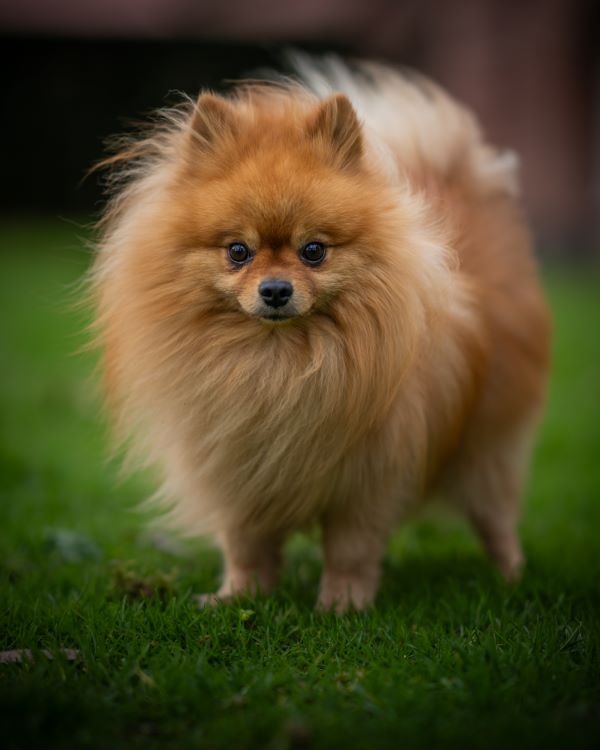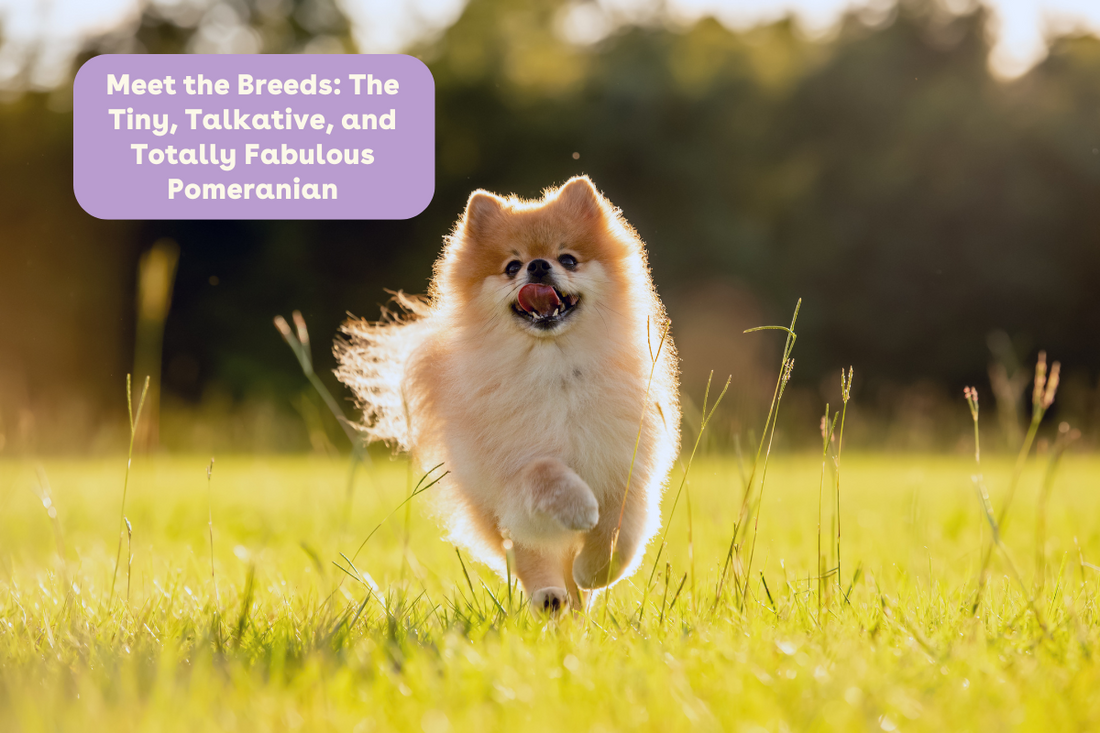Tiny, fluffy, and packed with personality, the Pomeranian might just be the most confident dog in the room. Don’t let the cotton ball shaped body fool you, this little lion has the attitude of a much bigger dog, and a heart that’s even larger.
Whether they’re trotting down the sidewalk like they own the place, curling up on your lap (and leaving a trail of hair behind), or alerting the entire neighborhood to a suspicious squirrel, Pomeranians bring a unique blend of spunk, loyalty, and pure cuteness.
If you’ve ever wondered what it’s like to live with one of these fluffy firecrackers (or you’re already lucky enough to call one yours), this guide is for you.
Table of Contents
- History of Pomeranians
- Breed Development
- Roles in Society
- Life Expectancy and Health
- Comprehensive Care
- Fun Facts About Pomeranians
History of Pomeranians

Ever look at a Pomeranian and think, "How did this walking cotton ball come to be?" Well, spoiler alert: the Pom’s ancestors were HUGE. Like, pulling sleds through snow huge. 🤯
Yep, before these puffballs were living the pampered life on designer dog beds, they were hard-working Spitz-type sled dogs from the icy regions of northern Europe. The breed gets its name from Pomerania, a stretch of land that now sits across Poland and Germany.
The shift from sled-puller to lap-snuggler really took off when Queen Victoria fell in love with the breed. She brought a little Pom named Marco back to England, and the whole country followed her lead. Thanks to her influence, breeders started scaling down the size, and voilà! The toy-sized Pomeranian we all know and love was born.
So the next time your Pom struts around like royalty, just remember, they kind of are.
Breed Development

Let’s be honest, Pomeranians don’t exactly look like they’re built for much more than strutting down the sidewalk like they own it. But hidden under all that fluff is a seriously fascinating breeding history.
Pomeranians are part of the Spitz family, a group of breeds known for their thick double coats, pointed ears, curled tails, and high intelligence. That means your tiny Pom is genetically related to dogs like Huskies, Samoyeds, and Alaskan Malamutes, breeds originally developed for pulling sleds, herding, and surviving harsh climates. Imagine a Pom the size of a Husky. Wild, right?
Originally, Pomeranians were much larger—closer to 20–30 pounds—and were used as working dogs in regions like northern Germany and Poland. But as their popularity spread, especially after Queen Victoria’s famous Pom, Marco, breeders began to selectively breed for smaller size, finer bone structure, and a plush, show-stopping coat. This process, called miniaturization, involves generations of careful breeding to preserve the traits people loved while scaling down the body size.
The result? A confident, expressive dog that might fit in your tote bag, but still carries the bold spirit and alertness of their sled dog ancestors. So, if your Pom has ever barked at a Great Dane like he’s the one who should back off, just know it's in their DNA 🤷
Roles in Society

These days, Pomeranians are pretty far removed from their rugged beginnings, but that doesn’t mean they’re just fluff and no function. Here’s how these floofs are making their mark:
Companionship
Unsurprisingly, Pomeranians are mostly kept as companion dogs. Their size and adaptability make them ideal for apartment living, and their loyalty and affection mean they bond deeply with their people.
They’re playful, social, and love being the center of attention, just try ignoring a Pom when they want your focus. (Spoiler: you can’t.)
They love being around their people, whether that means curling up in your lap, supervising your every move from the couch, or accompanying you on your daily errands in a backpack carrier (yes, I’ve seen it and yes, it’s adorable).
Therapy & Emotional Support Dogs
Their compact size, intelligence, and intuitive nature also make Pomeranians great emotional support animals (ESAs). While they may be too small to perform some traditional service dog tasks, they’re excellent at offering emotional comfort and companionship, especially for individuals living with anxiety, depression, or PTSD.
Social Media Stars
Ever heard of Jiffpom? Or Boo, the “world’s cutest dog”? These little fluffs basically invented the role of Instagram dog influencer. With their teddy bear looks and star-level charisma,
And let’s be honest, there’s nothing like a Pom in a sweater to cure a bad day.
Watchdogs (Sort of)
Despite their size, Pomeranians are natural watchdogs. While they don’t have the muscle to back it up, they do make excellent early warning systems.
They’re super alert and tend to let you know if anything is happening. A leaf falls outside? Bark. The wind changes direction? Bark. Someone dares walk past your window? Bark bark bark.
It’s kind of like having a very fluffy home security system.
Life Expectancy and Health

One of the benefits of small breeds like the Pomeranian is their long lifespan. Most Poms live between 12 to 16 years, and some even reach 18 or more with proper care and regular vet visits.
But, like all breeds, Pomeranians are prone to certain health issues. Here are a few to be aware of:
Common Health Concerns
- Tracheal Collapse: A weakening of the windpipe that can cause coughing or trouble breathing. It’s often triggered by pulling on a collar, so many Pom parents opt for a harness instead.
- Luxating Patella: A common issue in small breeds where the kneecap slips out of place.
- Dental Disease: Pomeranians are especially prone to plaque buildup and periodontal disease, so regular dental care is essential.
- Hypoglycemia: Especially in puppies, low blood sugar can cause weakness, disorientation, or even seizures if not managed properly.
- Alopecia X (Black Skin Disease): This condition causes hair loss and darkened skin, and while it doesn’t always impact health, it can affect appearance and comfort.
Grooming & Shedding
Let’s talk about that iconic pom look, you know, a cotton ball with eyes and attitude😉
That signature cloud of fur isn’t just for show; it’s a thick double coat, made up of a dense, insulating undercoat and a longer, coarser outer coat that gives them their puffball silhouette.
This beautiful coat is one of the breed’s standout features, but it definitely comes with some upkeep. Pomeranians shed year-round, with heavier shedding happening during seasonal changes—typically in the spring and fall.
To keep their coat healthy and tangle-free, daily brushing is ideal. It helps prevent matting, reduces shedding, and distributes natural oils that keep their skin and fur in good condition. Skipping regular brushing can lead to painful mats, especially around friction areas like the neck, armpits, and behind the ears.
💡Mistakes to avoid when grooming your pup at home!
Most Pom parents also schedule professional grooming every 4–6 weeks, which includes bathing, trimming, and sanitary cleanups. Some choose to keep their pups in a shorter "teddy bear cut" to make coat maintenance easier (though it’s important to never shave a Pom down to the skin, this can damage the coat and interfere with their ability to regulate temperature).
🐶Do dogs sweat? Learn how dogs regulate temperature!
If you’re not up for frequent grooming, a Pomeranian might not be your perfect match, but there are plenty of other small dogs out there that may be a better fit!
Comprehensive Care

Pomeranians are small, but they’re not necessarily low maintenance. Here’s what goes into keeping your Pom happy, healthy, and looking like the superstar they are.
Diet & Nutrition
Despite their small size, Pomeranians have high energy needs and should be fed a high-quality diet tailored for toy breeds. Look for foods rich in protein and healthy fats, and avoid fillers that can contribute to obesity.
❤️Shop Good Dog Food - the perfect well-balanced meal for your pup!
Portion control is key, these dogs are tiny, and even a small amount of overfeeding can lead to weight gain and related health problems.
💡Bonus tip: elevated bowls and slow feeders can help with digestion and pacing.
Exercise & Enrichment
Pomeranians may be tiny, but they are not couch potatoes. They need daily walks, short play sessions, and plenty of mental stimulation. Puzzle toys, short training sessions, and games like hide-and-seek can help keep their clever brains engaged.
While they don’t need miles of running like a Border Collie, a bored Pom can quickly become a barky, destructive Pom. Keep them exercised and entertained 😄
Training & Socialization
Like with any breed, early training and consistent positive reinforcement are key. Potty training may take longer than with larger breeds (smaller bladder = less time between potty breaks), and barking can become an issue if not managed early.
Because of their small size, Pom parents sometimes fall into the “small dog syndrome” trap, allowing behaviors they wouldn’t tolerate in larger breeds, but bad habits in a little dog are still bad habits.
Group puppy classes and early exposure to new people, dogs, and environments can help ensure your Pom grows up to be confident rather than fearful or reactive.
Be consistent, patient, and fun! Poms love being the star student if you give them the right motivation (like Pupford Training Treats!)
Grooming
If you thought having a Pom meant just a quick brush here and there—plot twist. Their grooming routine is a whole thing, and skipping it leads to mats, tangles, and a grumpy pup.
Here’s your to-do list:
- Daily brushing (yes, daily)
- Baths as needed (check with your groomer for how frequent baths should be for your specific pup!)
- Regular nail trims
- Clean those ears!
- And brush those tiny teeth like a dental hygienist on a mission
🐶Check out our At Home Grooming Course for more tips and tricks!
Fun Facts About Pomeranians

Because no breed blog is complete without some random facts…
- Queen Victoria’s Pom, Marco, set the trend for toy-sized Poms.
- Mozart had a Pom named Pimperl. He even wrote a song for the pup.
- A Pomeranian survived the Titanic (yes, really).
- They come in over 20 coat colors, talk about fashion options 💅
- Their fluffy tails curl over their back like a little feather duster.
Recap on The Tiny, Talkative and Totally Fabulous Pomeranian
Pomeranians are like a triple shot of espresso in a teacup. They’re smart, sassy, loyal, and a little bit extra in the best way. If you’re looking for a low-key, quiet lap dog... this probably isn’t your breed. But if you want a companion with huge personality, boundless energy, and an infinite supply of fluff, you’ve found your perfect match!
In other words? Life with a Pom is never boring, and we wouldn’t have it any other way.
Want to learn more about grooming, training, and feeding your Pomeranian like a pro? Sign up for Pupford Academy+ today!
Want the basics of dog training? Sign up for the 100% free online video course 30 Day Perfect Pup!









